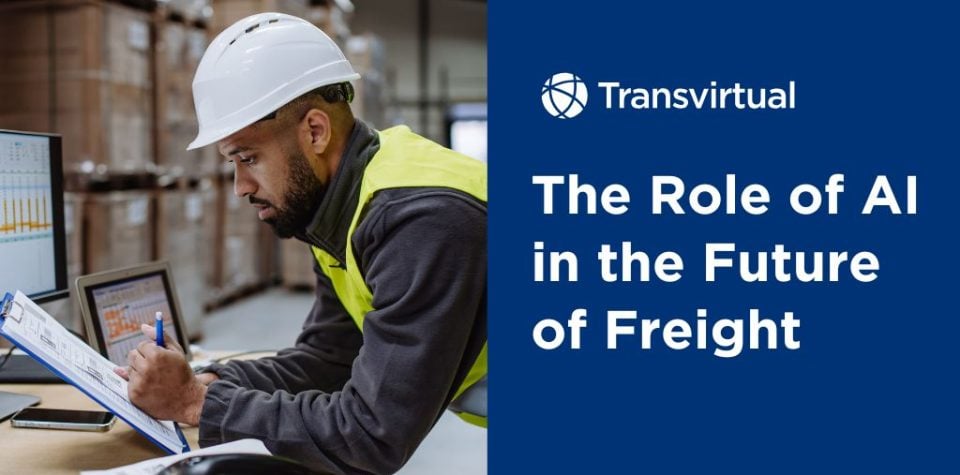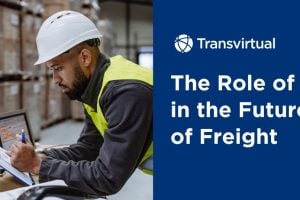Table of Contents
Freight has changed, and there’s no reason to believe that change is slowing down. Just a few short years ago, success in logistics was about gut instinct, tight scheduling, and coordination via phone calls and spreadsheets. But now, if you don’t integrate artificial intelligence (AI) and machine learning into your supply chain operations, you might be left behind.
It’s clear now that artificial intelligence isn’t a vague promise of the far future. It’s here, optimising routes, assisting with inventory management and analyzing market trends, ensuring customer satisfaction and streamlining warehouse operations with robotic precision. Freight moves differently now, and companies have to rethink their approach to efficiency, costs, and customer satisfaction.
AI in Logistics: Taking the Driver’s Seat (and the Back Office)
If you aren’t using AI systems already in your logistics operations, you might think this is all hypothetical. But it’s not – loads of big names in freight and parcel delivery are leveraging AI algorithms to enhance their supply chain.
UPS has their ORION platform (On-Road Integrated Optimisation and Navigation) which helps them plan driver routes. Amazon’s fulfillment centers are almost entirely managed by artificial intelligence, from scanning and sorting to delivery notifications. Even DHL uses AI for predictive analytics and demand forecasting, where their systems analyse delivery data, weather patterns, traffic models, and more. It’s a great tool for preventing supply chain disruptions.
All of this is to say none of what we’re talking about is a theory. Artificial intelligence exists now and is set to help logistics companies analyze customer data, historical sales data, and more.
AI for Robust Supply Chain Management
What exactly are the AI systems that are helping enhance customer satisfaction and your overall supply chain? If you’re unfamiliar with the topic, it all sounds like science fiction. In reality, it mostly falls under a few highly practical categories, including:
Machine Learning & Predictive Analytics
Machine learning tools are built on top of a mountain of historical and real-time data, helping businesses forecast demand more accurately by combining past trends with current conditions. These self learning digital systems perform some straightforward analysis to anticipate future demand for freight volume, delivery bottlenecks, inventory management, equipment maintenance requirements, or any aspect of your supply chain. It might seem like peering into a crystal ball, but it really does work for enhancing supply chain visibility and to analyze data.
Autonomous Vehicles & Drones
Autonomous vehicles, drones, and self-driving freight trucks are being tested around the world, particularly on highways in the US and Europe. For now, they prevent human error by running simple controlled routes between distribution hubs.
In the near future, you’ll see drone deliveries for more last-mile delivery scenarios. Pretty soon, paying a driver to sit in traffic will feel needlessly expensive, especially when considering operational costs. These technologies address key supply chain challenges, particularly in last mile delivery where efficiency matters most.
IoT and Smart Sensors
AI systems feed on data, and Internet of Things (IoT) devices provide a full buffet and are able to analyze vast amounts of data. Now we have sensors in trailers, pallets, shipping containers, and more to provide constant updates on temperatures, predictive maintenance, positions, and delays in delivery schedules.
Digital Twins
These are a little more niche but are becoming more popular within the logistics sector. Digital twins are virtual replicas of physical systems like warehouses or shipping routes. They’re used to simulate performance, like being able to test-drive in a digital sandbox before making actual changes in the real world.
You may not be using any of these yet, and you may not need them just yet. But keep in mind that your competitors might be, or plan to apply them to their logistics processes in the near future.
Logistics Companies Leveraging AI
For some more specific examples, look to Uber Freight. They’re using AI to match shippers with carriers, optimise routes to reduce deadhead miles, and much more. The company has reported that AI has helped them save fuel, time, and money, analyse customer behavior while also improving driver morale.
Volvo and DHL partnered up recently to launch autonomous freight runs. Their driverless rigs handle short, fixed routes with an impressive degree of reliability.
In the ocean logistics industry, CMA CGM partnered with Google to integrate AI into their vessel and container tracking. They’ve seen fewer empty containers idling in ports, smoother inventory management, lower logistics costs, and faster turnarounds.
Each example we’ve shown demonstrates quite seriously that AI is no longer an abstract idea. Your business has every reason to adapt and adopt ASAP.
Real-World Benefits of AI in Freight
If AI were just a neat toy, or still a fun literary device from old school sci-fi novels, we wouldn’t be writing this. But it’s not, and we are writing this because the numbers back it up. Implementing AI technology has become synonymous to efficient supply chain management.
Don’t believe us? Well, logistics companies worldwide are seeing significant gains across:
Operational Efficiency: AI tools run 24/7 without tiring. They don’t need lunch breaks. Delays shrink when your fleet scheduling is run by algorithms. Your warehouse operations also improve as mistakes happen less and less.
Cost Savings: Route optimization that leverage AI algorithms can lead to fewer miles traveled and less fuel burned. AI powered tools help you achieve fewer breakdowns, less overtime, and a better customer experience overall. These wins add up fast, especially across national or global operations.
Scalability and Optimization: By combining historical data and current data, businesses can make intelligent decisions, address problems before they become serious and cause downtime.
Customer Satisfaction: Customers’ lives are easier when they benefit from real-time updates, tighter ETAs, and fewer missed deliveries. All of that makes them far more loyal as well.
·Sustainability: The logistics industry is hardly the most eco-friendly, but AI can help you shrink your carbon footprint dramatically. Minimising unnecessary trips and streamlining your supply chain means the customers that care how their goods get to them will trust you that much more.
What’s Next? Building Smarter Freight – Together
We’re still early in this story, but the tools are getting sharper. AI is in many ways already driving the freight logistics world forward. The question is: will you be watching from the sidewalk, or in the cab with it?
The Transvirtual team is always ready to explore how smarter systems can serve the logistics industry and build a more resilient supply chain. Dispatchers, drivers, fleet managers, and their customers. If there’s an AI use case you’ve been thinking about, something you wish your platform could do, predict, or automate – we can’t wait to hear about it.
Reach out to a member of our team today. Let’s figure out what’s next, together.


